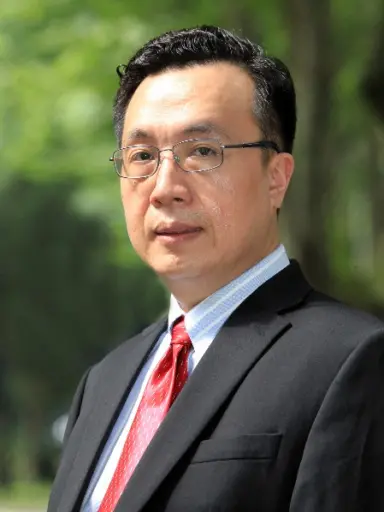In the not-so-distant future, a city full of autonomous cars may have to weather a snowstorm.
It’s a scenario that’s not unusual to places like Madison, but it presents a unique challenge for automated vehicles that may rely on tools like cameras or lidar to see where they’re going. Heavy snowstorms can be challenging for drivers; for automated vehicles, they could prove crippling as visibility drops or precipitation obscures their sensing devices.
Bin Ran, the Vilas Distinguished Achievement Professor in civil and environmental engineering at UW-Madison, is leading a years-long research effort to better understand how to “train” autonomous vehicles to navigate difficult road conditions. To aid their research, he and his students are using CARLA, an open-source simulator that allows them to create and study customized AV driving scenarios.
 Bin Ran
Bin Ran
“With snow, you can’t see your lane, and that can make it very difficult for autonomous cars to navigate,” Ran says. “Even with our current autonomous cars, drivers can still take over and drive in poor conditions. But in the future, if all cars are fully autonomous and there are situations where the cars can’t understand what’s going on, the cars would have to stop. Imagine that happening in a big city. It would be a disaster.”
Ran works with UW-Madison’s Traffic Operations and Safety Laboratory and has been overseeing the CARLA project since summer 2019. The research team uses CARLA to input parameters to set conditions and simulate how an autonomous car might behave in certain circumstances. The project has, thus far, focused on two big challenges for autonomous vehicles—navigating in difficult weather conditions such as snowstorms or rainstorms, and navigating through construction zones.
Stephen Kocmoud, a first-year CEE graduate student working on the project, says CARLA has parameters created by professors around the world to simulate how a driver might trail another vehicle or react to an obstacle on the road. The UW-Madison investigators can pull those parameters into their simulation, which allows them to focus on determining how an autonomous vehicle might behave around other cars on the road.
“The hope is that we can build up the simulation to get a new circumstance to see how the vehicle responds,” he says. “For example, seeing what happens if we tweak this work zone a certain way. We want to work up to that so we have a better understanding of how these autonomous vehicles behave, depending on how factors in the environment change.”
Ran sees an answer to these challenges by leveraging connected infrastructure. Connected infrastructure uses “smart” technology to connect roadside infrastructure to vehicles. Such systems allow cars to “talk” to the roadside infrastructure and to each other to access more information than an individual vehicle could gather on its own.
Yifan Yao and Keshu Wu, both third-year CEE PhD students in the Connected and Autonomous Vehicle Highway graduate research group, are tackling that challenge. They’re working to design a system that would allow smart roadside units to communicate with autonomous vehicles in difficult weather conditions or in construction zones.
“If there’s a distant work zone coming up, the car might not know that on its own,” Yao says. But if we have these roadside units, they can beam that information to the car so the system and driver know what’s coming. It can alert the vehicle to say here what’s coming up and the path you need to take to get safely through it.”
Construction zones are particularly challenging for autonomous vehicles because the cars may have to ignore the lane striping they typically use for guidance. Cones might obscure the path through a work zone, and workers on foot could further complicate navigation. However, a connected roadside unit in a construction zone could broadcast routing information to approaching vehicles to help them navigate this otherwise dynamic area.
“You have to bring the road and the car together,” Ran says. “If you want to do that, everything has to work as one system—otherwise the car will stop and there’s nothing it can do.”
The CARLA project draws in undergraduate students not only from across the College of Engineering but from other disciplines at UW-Madison. Ran says data and computer science students work on the project, as well as students who focus on civil, mechanical and systems engineering. It’s a popular project for undergraduates—90 applied to work on it for the spring 2022 semester, and 20 of those were selected to work on the project alongside graduate students.
Noah Leonard, a fifth-year senior studying civil and environmental engineering, joined the CARLA project for the spring 2022 semester. He’s had some prior experience working with similar simulation software through a summer co-op with SRF Consulting, though he says that focused more on human elements in transit.
“It’s been really neat for me because I don’t think a lot of undergraduate students have the chance for this type of exposure to the topic,” Leonard says. “Autonomous vehicles act differently than humans, and the hope is that we can one day get them to be smarter on the road than human drivers. So the really interesting part has been figuring out how we integrate autonomous vehicles into our transportation systems and how we might one day phase out human drivers to go fully autonomous.”
For Ran, the CARLA project offers a unique opportunity to expose the next generation of engineers to the challenges that will come with the slow transition toward autonomous vehicles. He hopes the exposure will help Badger engineers lead the charge in creating solutions for those challenges.
“Many of our undergraduates will go into industry when they finish here, and we have to train them to be prepared for that,” Ran says. “There’s a revolution coming in the automotive field, and I want them to know that they will be the champions of the effort.”